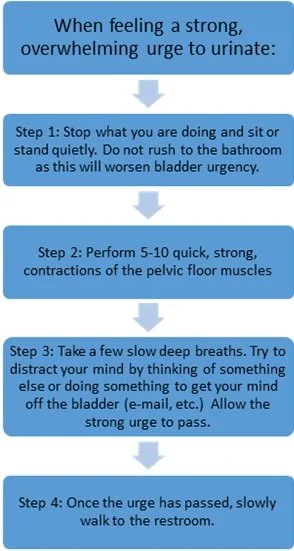How should urgency suppression strategies be modified for the tender or “hypervigilant” pelvic floor muscles?
Urinary urgency, frequency and incontinence are complex and involve the interactions of multiple systems (somatic, visceral and neurological). These three problems are treated commonly in pelvic physical therapy and women's health physical therapy practices. Urgency suppression strategies were initially developed based on these systems- with the understanding that the pelvic floor muscles were not contributing their part to the system. In my opinion, this was largely based on the understanding the incontinence/ urgency occurred when the pelvic floor muscles were not strong enough to properly hold back urine. But, over time we have learned that this is not always the case. (See my recent post here).
Understanding When to Apply Urgency Suppression Techniques
So, do the same urgency suppression techniques apply for a tender pelvic floor muscle group? How should urgency suppression techniques be modified for the overactive, shortened or hypervigilant pelvic floor?
To understand this, I first need to introduce you to the standard urgency suppression techniques.
Now, please don’t take this as “Jessica doesn’t think urgency suppression techniques work,” because that is simply not true. I use these in the clinic all the time—for my patients who are experiencing urgency or urge incontinence and have weak, under-functioning pelvic floor muscles. These techniques work for this population a few different ways:
Deep breathing facilitates the parasympathetic nervous system which helps to keep the walls of the bladder relaxed thus allowing the bladder to fill and decreasing urgency. This breathing also helps to decrease the emotional fear that a person may feel (“Ahh, I hope I make it to the bathroom!”) which also will calm urgency due to the impact this has on the brain.
Strong, quick, contractions are thought to stimulate the neurological connection between the pelvic floor muscles and the bladder. Basically, quick contractions tell the bladder “it is not yet time to empty” and the bladder relaxes its contractions (which make us feel the strong urge) helping to calm urgency.
Distraction/Visualization are ways to get the mind off of the bladder and on to something else. Remember when you needed to go to the restroom, but got busy and forgot you needed to go? This aims to utilize that same mechanism to calm urgency and allow postponement of the urge.
Modifications For Overactive Pelvic Floor Muscles
Sounds great, right? And it is—really great for people who are experiencing urgency and have weak, underactive pelvic floor muscles. But what about for the people having overactive/shortened/hypervigilant pelvic floor muscles?
My thought process is that these techniques have to be modified to allow them to be effective for this population. First, we will keep a few steps and here’s why:
Deep Breathing & Distraction/Visualization
I actually love these (especially the calm breathing) for my patients with difficulty relaxing the pelvic floor muscles. I often find that people with overactive pelvic floor muscles tend to be in a sympathetic-drive state for their nervous systems. Remember, the sympathetic nervous system is the “fight-or-flight” response. People who have chronic pain or chronic urgency/frequency often will have a significant amount of stress and fear, and I find that this state of their system often facilitates poor breathing patterns and overall increased tension and poor force modulation (meaning, choosing the right amount of muscle activity for the current task at hand). My colleague, Seth Oberst, wrote an amazing post about this very thing recently (I could write an entire post applying all of that to the pelvic floor!). So, we’ll keep these steps—with an emphasis on slow, calm breathing, utilizing the diaphragm and emphasizing relaxation of the pelvic floor with the inhale and returning to baseline with the exhale.
But here’s where we modify:
Quick, Strong, Pelvic Floor Contractions
My issue with this component for the overactive or hypervigilant or shortened pelvic floor muscles stems from a few key points. Traditional “kegels” or pelvic floor strengthening exercises are contraindicated for people with pelvic pain (or in my mind, anyone who has a tender, hypervigilant or overactive pelvic floor). Performing quick contractions for this population often will create pain, worsen the patient’s symptoms and actually increase urgency. You heard that right. Did you know that the pelvic floor muscles can actually refer to the bladder? I have had many instances when examining a person’s pelvic floor muscles that he/she reported that even lightly pressing on certain muscles made him/her feel urgency. And we know that somatovisceral convergence (a muscle impacting an organ) is real, and does occur. So, what do we do about this step?
We use this relationship in our favor.
Instead of quick, hard contractions, the person can perform deep breathing and pelvic floor drops (emphasizing complete pelvic floor relaxation). Although initially, some of my clients will worry that relaxing the pelvic floor muscles will “open the flood gates” this does not typically occur. Instead, relaxation of the pelvic floor combined with breathing will often calm down the detrusor (bladder muscle) activity and allow them to feel decreased urgency.
New Urgency Suppression Strategies
So, what do these new urgency suppression strategies look like?
What do you think? If you have a tender pelvic floor and/or pelvic pain, I encourage you to give it a try! Let me know what you think! As always, I would love to hear from you!


